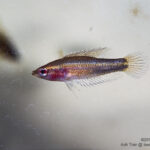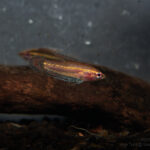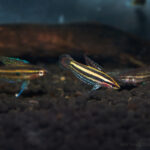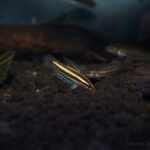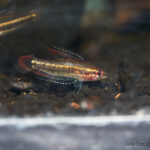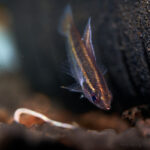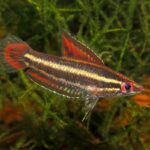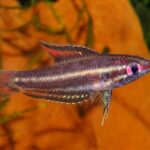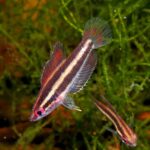Parosphromenus opallios
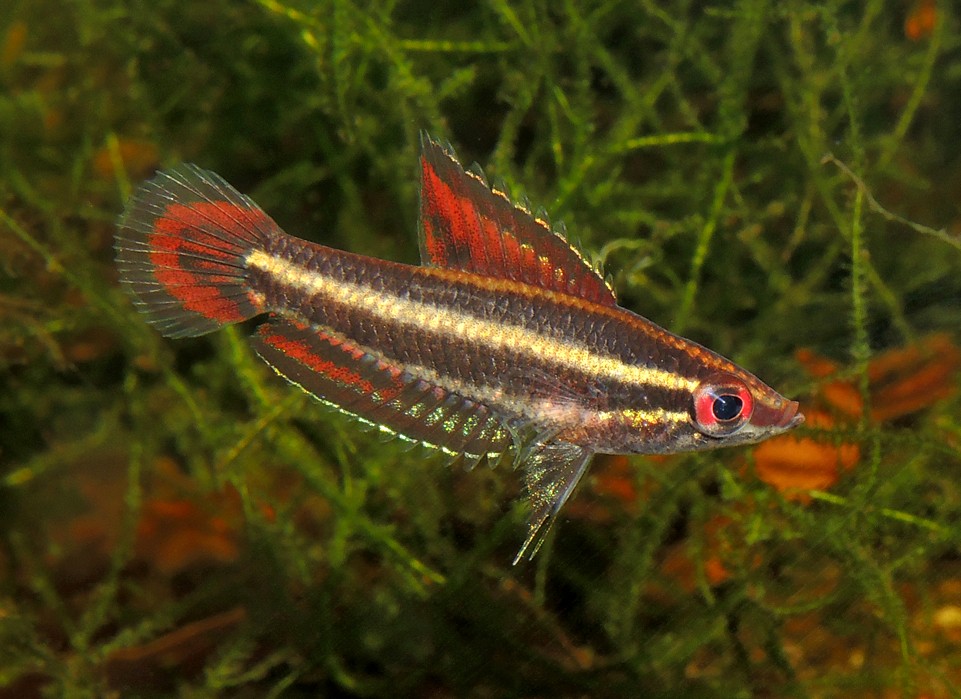
Kottelat & Ng 20
First description:Diagnoses of six new species of Parosphromenus (Teleostei: Osphronemidae) from Malay Peninsula and Borneo, with notes on other species. The Raffles Bulletin of Zoology 2005 Supplement No. 13: 101-113.
Characteristics: total length max. 3.5 cm. Dorsal structure: XI-XIII, 6-8, total 18-19, anal fin: XI-XII, 10-11, total 21-23. ♂ in breeding colourit often becomes very dark, with varying (depending on the locality), usually striking red zones, whitish-turquoise coloured fin seams, and blue-colored, spotted ventrals with light blue filaments, ♀ distinctinguished, besides the much paler overall colouration and the lack of bright edges of the uncoloured unpaired fins, especially by the less pointed dorsal fin, which often appears rounded. The body often appears slightly compact. – Variations see below.
Similar species: for the males mainly possible (on first glance) with other partially red-finned species of the bintan-harveyi group, like rubrimontis or alfredi but upon closer inspection well distinguishable in full breeding condition by the characteristic colour distribution. In females, the fish can certainly be easily confused with other species of the bintan-harvey group.
Occurrence / Distribution: Borneo: Kalimantan Tengah, Sukamara area, river basin of the Jelai Bila, at Kalimati in the Arut Basin (Lamand region) close to Pangkalanbuun and in the Benipah river SW Kubu. Linke measured a conductivity of 9 micro Siemens / cm, hardness values less than 1 degree KH and GH and a pH slightly below 4.0 in dark brown colored water. The fish were found mainly in the heavily overgrown shallow littoral zones. The species lives together in some of their habitats with linkei. As today a much wider area of distribution is known as it was assumed before (“Sukamara”), it is possible to most likely that different forms, which partly vary significantly regarding colouration, indicate the presence of variants, whose genetic identity or separation is still completely unknown.
Threat: very high, just like many other species, because of rain forest destruction. This is true especially for the lowland forms and even more, as the variation of the species is obvious and indicates probably an already ongoing division in (also) genetically separated populations.
Discovery/First import:collected for the first time by Kubota, Linke et al. in 1990. Probably earlier, but then not recognised as a distinct form. The fish was named “P. spec. of Sukarma” until the first description in 2005.
Trade: the species was initially known only from private imports, but has been traded comercially to a limited extent as well recently.
Care / Breeding: not different from the standard breeding conditions. A a low germ densitiy is very important, which can be achieved by low pH value (max. 4.5) and the presence of humic substances. Probably failed breeding attempts go back to population differences, but the background is still unknown.
Behaviour / Particularities:standard cavity nesters. The species belongs to the head-down-courtshipers. It is striking that the naturally colorful fish occasionally lose their intense color in aquariums, especially after succesive generations. However, most likely, wrong water parameters are the reason for this.
Literatur:
Weblinks:
P. opallios by Ahn Tran, Black Water Aquatics
These fish were imported by Black Water Aquatics in 2019 and originated, according to the exporter, from the same area inhabited by P. linkei. They also appear to possess markings quite similar to P. opallios. With these two factors, it could be reasonably surmised that these are, in fact, P. opallios or a very closely related form.
P. opallius © David Jones


